North Carolina is a beautiful state in the southeastern region of the United States. It has a vast array of habitats – with the Coastal Plain in the east, the Piedmont region in the center, and mountains in the west. However, it is also home to many animals, and some of the most abundant animals in the state are snakes. There are 37 snakes in North Carolina, including six that are venomous. One of the best-known of these is the cottonmouth, so join us as we learn all about the cottonmouths in North Carolina, including how dangerous they are, how often they bite, and where they live!
About Cottonmouth

Cottonmouths are venomous snakes.
©iStock.com/Saddako
There was originally only one single species of cottonmouth which had three subspecies – the eastern, western, and Florida subspecies. However, research eventually proved that there was no distinguishable difference between the western and eastern subspecies, but that the Florida subspecies was different. Therefore, the eastern and western subspecies simply became one single species – the northern cottonmouth – while the Florida subspecies became its own species (Agkistrodon conanti).
Northern cottonmouths (Agkistrondon piscivorus) are large snakes that typically attain lengths of between 30 and 48 inches. They have heavy bodies which are dark brown to black in color. These snakes also have darker crossband markings which in some cases can be almost indistinguishable if the snake has a particularly dark ground color. Cottonmouths have large heads with blunt snouts and two heat-sensing pits between their eyes. Additionally, cottonmouths have keeled dorsal scales which means that each scale has a raised edge. However, juvenile cottonmouths are tan or light brown and have reddish-colored crossbands. They also have a yellow tip on their tail.
The best-known feature of every cottonmouth snake is the appearance of its mouth – the inside of it to be exact. This is because all cottonmouths have a white lining inside their mouth which resembles cotton – hence their name. Cottonmouths usually display this while they are in a defensive position. This is when they coil their bodies and open their mouth at the same time to expose the white coloration.
Where do Cottonmouths Live in North Carolina?
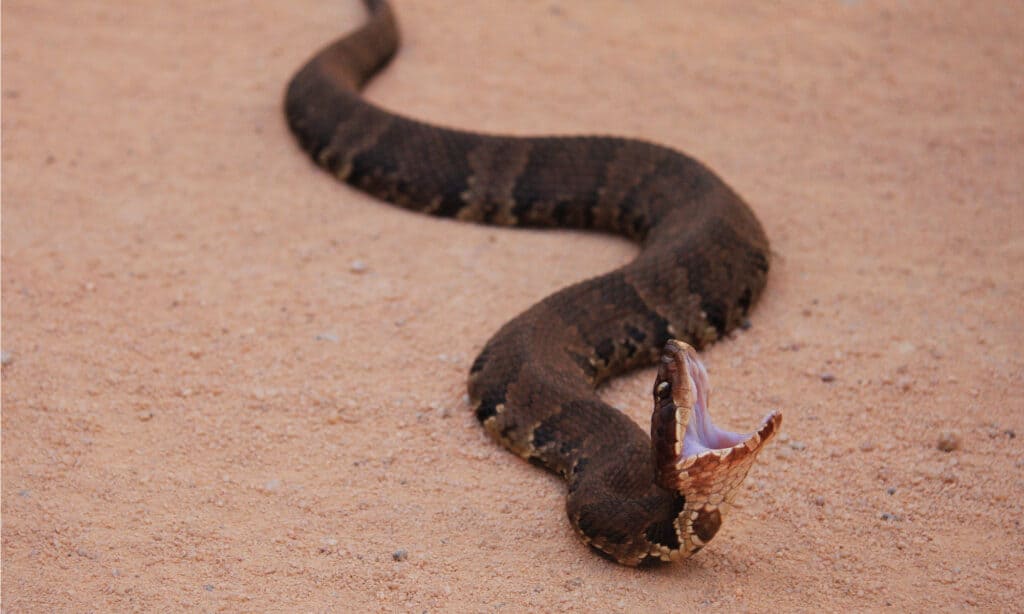
You can find cottonmouths across the Coastal Plain in North Carolina.
©Nathan A Shepard/Shutterstock.com
Cottonmouths are semi-aquatic snakes and are excellent swimmers. Therefore, they are usually found in and around water – such as rivers, lakes, streams, swamps, and ditches. However, cottonmouths are not found across the entire state of North Carolina. Instead, they occur only in the eastern half of the state – mainly across the Coastal Plain and in some areas of the Outer Banks. They are abundant across their range though, and in some places, they are the most common snakes in the area.
Like most snakes, cottonmouths enter into a state known as “brumation” for the winter. During this time they live in crevices, underneath rotten logs, or even in abandoned burrows. They are most active between April and October and are primarily nocturnal which reduces the chances of you encountering one. However, cottonmouths can sometimes be spotted basking in the sun near the water’s edge.
During their active period, cottonmouths prey on a wide variety of animals both in and out of water. These include birds, fish, lizards, small mammals, and snakes.
How Dangerous are Cottonmouths in North Carolina?
Snakes are one of the most widely feared animals in the world. Statistically, venomous snakes inflict 7,000 to 8,000 bites in the US per year – resulting in an average of five deaths.
When it comes to cottonmouths, they are responsible for only around 1% of these. However, if we only take into account bites inflicted in the known range of cottonmouths then this figure rises to 7.3% – meaning that they are pretty dangerous snakes. Despite this, there are no records of any deaths caused by cottonmouths in North Carolina.
Cottonmouth Venom
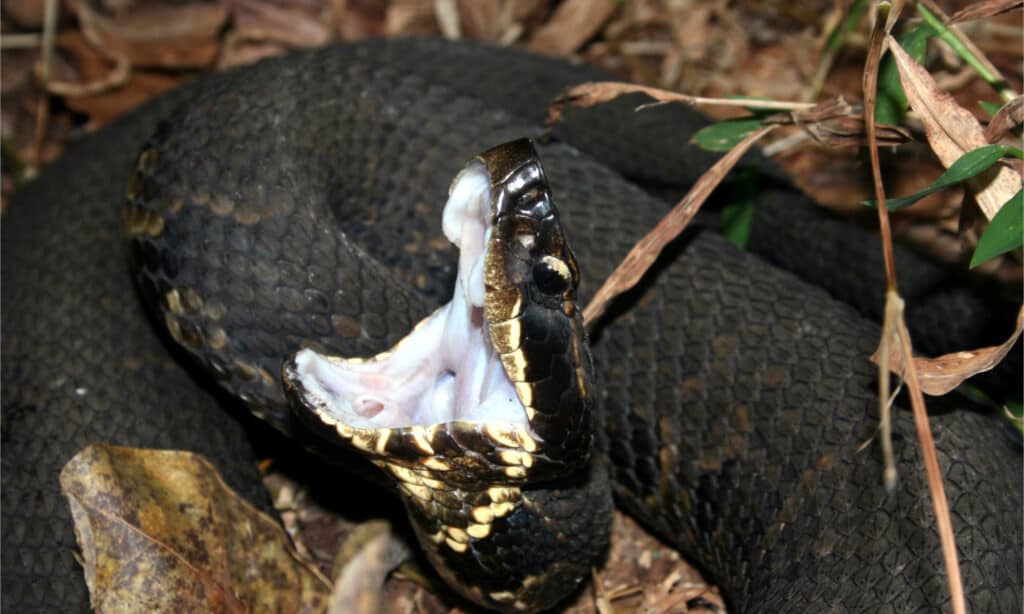
Cottonmouths have potent venom.
©Psychotic Nature/Shutterstock.com
Although no one has died from a cottonmouth bite in North Carolina they are still extremely dangerous snakes. Venomous snakes usually contain either hemotoxic, cytotoxic, proteolytic, or neurotoxic venom which attacks the body in different ways. Cytotoxic venom works by destroying tissue and this is the venom that cottonmouths contain. Even though it is rarely fatal, cottonmouth venom can cause extensive scarring and tissue damage. In some cases, the damage can be so severe that amputation of the affected limb is needed.
Cottonmouths also contain a lot of venom and each bite produces an average of 125mg, with the highest amount being in the region of 237mg. A lethal dose for a human is estimated to be between 100 and 150mg.
However, although cottonmouths undoubtedly have very potent venom, they are actually not the most venomous snake in North Carolina. Instead, they are classed as being the fourth venomous snake in the state – after the eastern diamondback rattlesnake, timber rattlesnake, and coral snake.
What Should You Do if You See or are Bitten by a Cottonmouth?
Most bites from venomous snakes are caused by them being accidentally stepped on. However, in the case of cottonmouths, bites can happen in the water too so the first thing is to always be vigilant and tread carefully.
If you see a cottonmouth, then you should never approach it. It is estimated that around 50% of all cottonmouths try to escape when they are disturbed and they are less likely to strike if you back away and let them move away. Cottonmouths see the water as their safe place so never stand between a cottonmouth and a source of water. However, it is also estimated that around 78% will try to use a defensive display if they are unable to escape straight away.
The main symptoms of a cottonmouth bite are swelling of the affected limb and intense pain in the area of the bite. Even if you don’t think the bite is serious, any bite from a venomous snake can quickly become much worse in a matter of hours. Therefore, it is imperative that you seek medical help immediately. There is antivenom available to treat cottonmouth bites. However, for the best results, it needs to be administered as soon as possible.
Other Aquatic Snakes in North Carolina
Although there are five other venomous snakes in North Carolina, we would mention a few of the other snakes that are easily mistaken for cottonmouths – namely water snakes. It’s important to know the differences between these snakes. Unfortunately, these non-venomous snakes are often killed or maimed by people who think that they are dangerous cottonmouths.
Banded Water Snake
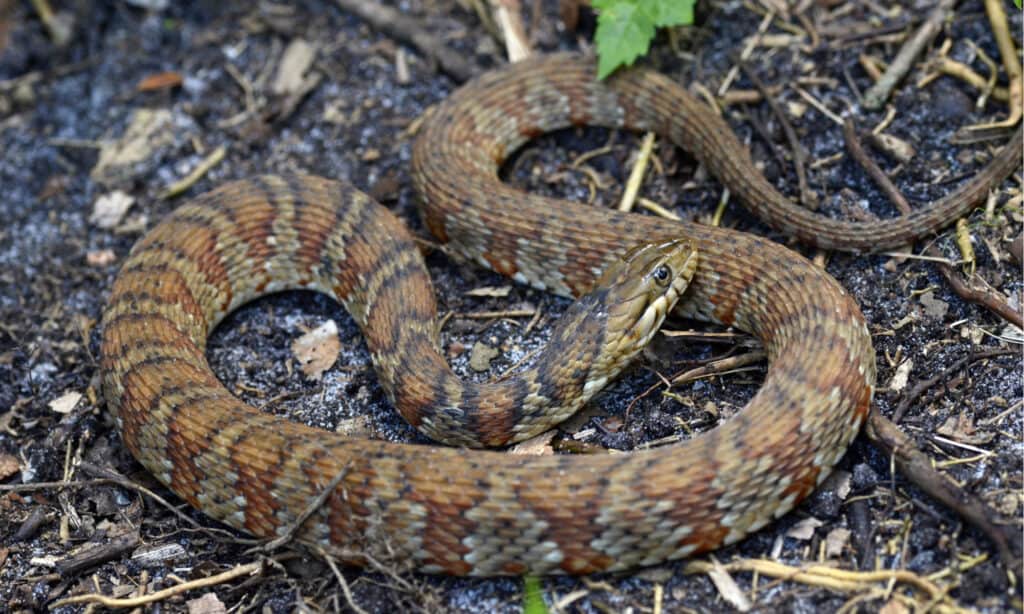
A banded water snake is commonly mistaken for a cottonmouth.
©Patrick K. Campbell/Shutterstock.com
The banded water snake – also known as the southern water snake – is a heavy snake that is typically between 24 and 42 inches long. It has a greenish-gray to brown body with dark brown crossbands. These snakes can sometimes have a dark enough ground color that their crossbands are indistinguishable – like the cottonmouth. However, banded water snakes have dark stripes from their eye to the corner of their mouth. They are abundant across much of the same region as cottonmouths but tend to prefer to live in swamps and marshes.
Northern Water Snake
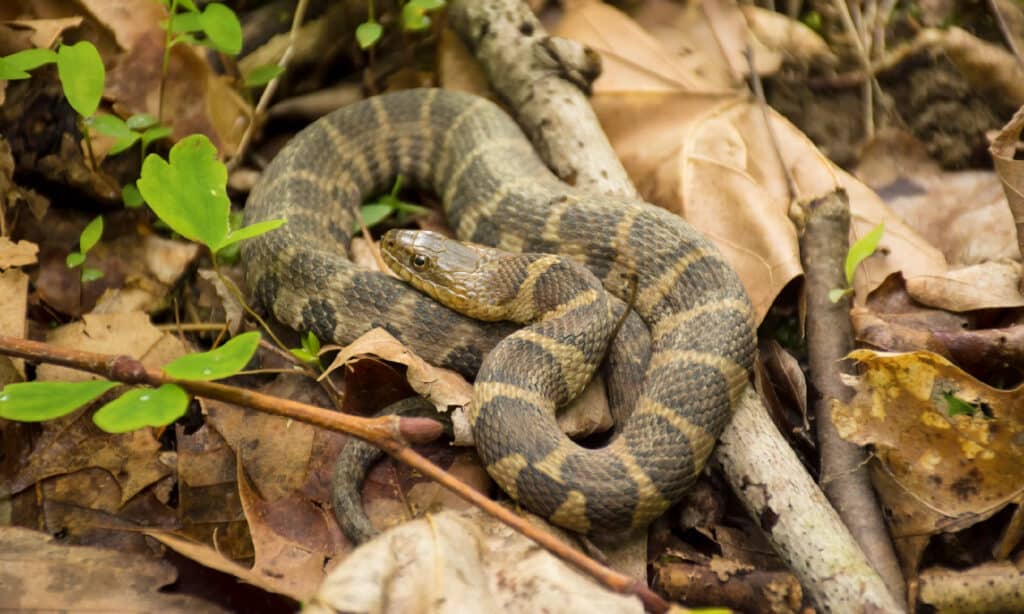
Northern water snakes are not venomous.
©iStock.com/IcemanJ
The northern water snake is the snake that is most often mistaken for the cottonmouth. This snake is often brownish-black with dark crossbands and blotches. Although it is not venomous, it readily bites if disturbed. Northern water snakes are found across the majority of the state – with the exception of the southeast corner – and live in virtually any freshwater habitat.
Brown Water Snake
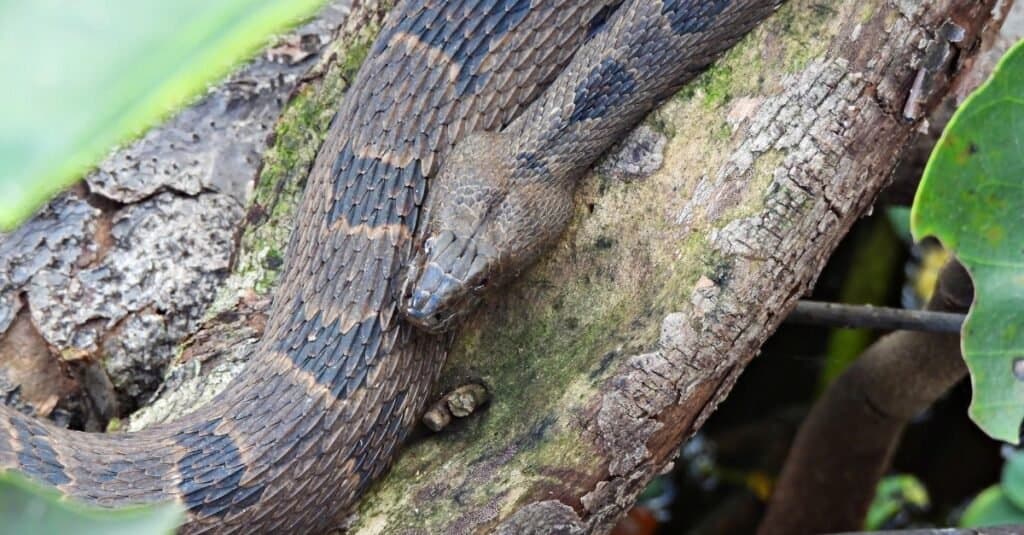
Brown water snakes have a triangular head, with the eyes being set toward the top.
©iStock.com/passion4nature
The brown water snake is another water snake that is found across much of the same range as the cottonmouth. However, they are mainly found in rivers and streams. These snakes are usually 30 to 60 inches long and have brown bodies with dark brown or black blotches. If they are handled then they bite readily and release a foul-smelling musk.
Which U.S. State Has the Most Snake Bites?
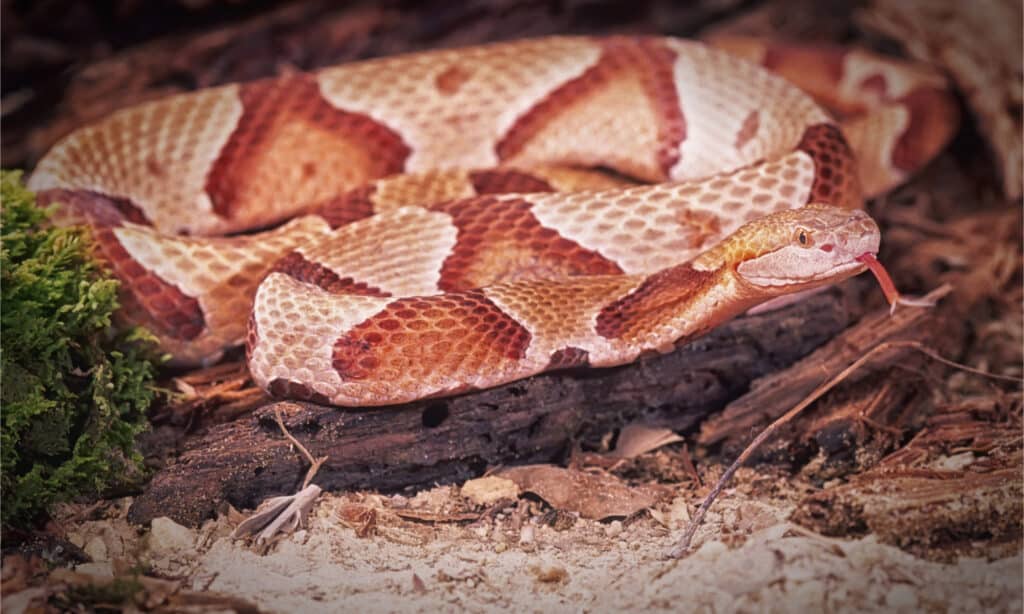
The venomous copperhead snake is among those responsible for snake bites in North Carolina.
©outdoorsman/Shutterstock.com
We know that cottonmouths are a risk to North Carolinians if you encounter them in the wild or elsewhere. Most snake bites occur when humans try to interact with snakes they encounter, either by attempting to remove them or terminate them. While certain states have very low numbers of reported snake bites, others are high on the list.
So which state ranks the highest in snake bites? That would actually be North Carolina! The snake bite rate in this southeastern state is 157.8 bites per million population annually. As the population as of 2021 was a little over 10 million (10.55 to be exact), and we were to just figure it off of 10 million, that would average out to roughly 1,580 reported snake bites per year.
The top 6 states for reported snake bites are:
- North Carolina 157.8 bites per million
- West Virginia 105.3 bites per million
- Arkansas 92.9 bites per million
- Oklahoma 61 bites per million
- Virginia 48.7 bites per million
- Texas 44.2 bites per million
The 6 different kinds of venomous snakes inhabiting North Carolina are copperheads, cottonmouths, eastern coral snakes, eastern diamondback rattlesnakes, pigmy rattlesnakes, and timber rattlesnakes. In the year 2019, there were 92 people bitten by venomous snakes in that state.
The photo featured at the top of this post is © Ad Konings/Shutterstock.com
Discover the "Monster" Snake 5X Bigger than an Anaconda
Every day A-Z Animals sends out some of the most incredible facts in the world from our free newsletter. Want to discover the 10 most beautiful snakes in the world, a "snake island" where you're never more than 3 feet from danger, or a "monster" snake 5X larger than an anaconda? Then sign up right now and you'll start receiving our daily newsletter absolutely free.
Sources
- NC Wildlife, Available here: https://www.ncwildlife.org/portals/0/learning/documents/profiles/cottonmouth_091611.pdf
- Live Science, Available here: https://www.livescience.com/43597-facts-about-water-moccasin-cottonmouth-snakes.html#:~:text=%22Like%20all%20pit%20vipers%2C%20%5B,which%20is%20often%20potential%20prey.
- Centers for Disease and Prevention, Available here: https://www.cdc.gov/niosh/topics/snakes/default.html#:~:text=Each%20year%2C%20an%20estimated%207%2C000,than%20to%20die%20from%20them.
- National Library of Medicine, Available here: https://www.ncbi.nlm.nih.gov/books/NBK546645/
Thank you for reading! Have some feedback for us? Contact the AZ Animals editorial team.






